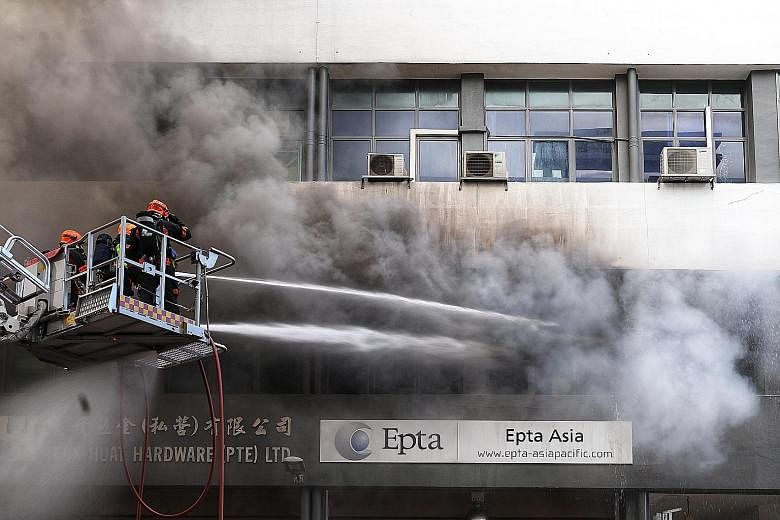Older buildings as well as those whose occupants face a higher risk in the event of a fire may soon be required by law to install critical fire safety features to keep up with the latest Fire Code.
So far, some 500 buildings have been identified as requiring these features. This is based on the fact that they were built before the 1991/2002 Fire Code and have a higher occupancy load, as well as the profile of their occupants.
For example, International Plaza in Anson Road has not undergone addition and alteration works since it was constructed in 1976.
While the high-rise commercial and residential building is compliant with the 1974 Fire Code, it lacks exit staircases that lead to outdoor areas, which would be safer for evacuees during a fire emergency.
The new requirement is part of proposed key changes to the Fire Safety Act tabled by the Ministry of Home Affairs in Parliament yesterday.
A Singapore Civil Defence Force (SCDF) spokesman said the 1991 edition of the Fire Code had introduced a suite of enhancements to facilitate evacuation, fire-fighting and smoke control, such as the requirement to have exit staircases designed to facilitate evacuation of occupants.
The 2002 edition introduced additional fire safety requirements for healthcare institutions, such as the need to cater for safe areas of refuge on all floors, to facilitate evacuation of patients with mobility issues.
"Buildings built before these two versions of the Fire Code remain fire-safe as they have fire safety measures in place. However, installing the additional upgrades will further enhance the safety of the occupants of the buildings," the spokesman told The Straits Times.
Of the 500 buildings identified, 460 were built based on the pre-1991 edition of the Fire Code, and 33 buildings were built based on the pre-2002 edition. They are mostly commercial, industrial and government buildings.
Building owners who do not comply with the requirement will face a maximum fine of $50,000 and/or a jail term of up to 12 months, as well as a $1,000 fine per continuing day after conviction, said the spokesman.
But to allow building owners to meet the requirements, the SCDF said it would exercise flexibility in the implementation on a case-by-case basis and may accept alternative solutions or grant time extensions to allow building owners to meet the requirements.
"SCDF has been working closely with such building owners to prioritise more critical upgrades and help them address their constraints," said the spokesman.
The Fire Safety (Amendment) Bill also proposes the creation of new offences to target contractors and suppliers of non-compliant fire safety products or materials in buildings.
Those who knowingly use or cause the use of such materials may be fined $100,000 and face a jail term of up to two years, while those who negligently use or cause the use of such materials may be fined $50,000 if no harm was caused.
The law now stipulates that building owners can be prosecuted for the use of materials or products that are not compliant with fire safety codes.
But supply chain actors such as contractors and suppliers are not mentioned in existing law.
These proposed offences come after fatalities from recent building fires in Singapore and other countries such as Britain, most notably the fire at London's Grenfell Tower in June 2017 that killed 71 people. It was later found that the external cladding of that building had accelerated the spread of the blaze.
In May that same year, a 54-year-old woman died in Singapore after fire broke out at an eight-storey industrial complex in Toh Guan Road.
Investigations by the SCDF found that the building and 35 others in Singapore were using external cladding that may not adhere to safety standards in the Fire Code.
Another proposed amendment is enhancement of the enforcement and investigative powers of the SCDF.
This would allow it to immediately prosecute building owners for serious fire hazards such as overcrowding, non-maintenance of fire safety measures and the obstruction of escape routes.
These fire hazards are typically found at public entertainment outlets and shopping centres, especially during seasonal festivities.
Currently, the SCDF can take action against errant building owners only when Fire Hazard Abatement Notices are not complied with.


